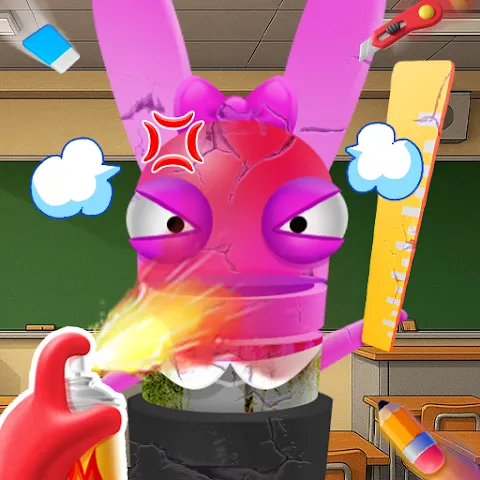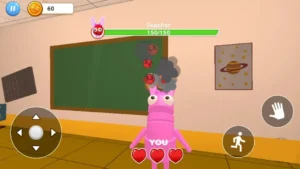
Codenames
Role-Playing

| App Name | Bad Student: School Prank |
|---|---|
| Latest Version | 1.0.1 |
| Last Updated | 18 Mai 2025 |
| Publisher | Mirai Games |
| Requirements | Android Android 7.0+ |
| Category | Role-Playing |
| Size | 162.9 MB |
| Google Playstore |

|
In every classroom, teachers and peers can usually identify the so-called “bad student.” This label, however, is often an oversimplification of a much more complex situation. A “bad student” might be someone who frequently skips homework, talks during lessons, or disrupts the class. But these behaviors are often symptoms of deeper issues rather than signs of laziness or disinterest. Using such a label can be harmful, affecting how the student sees themselves and how others treat them. It sets a negative expectation that many students may unfortunately live up to, simply because they feel like there’s no way to change how they’re seen.
Being labeled a “bad student” can significantly affect a child’s academic journey. Once categorized this way, students are often denied the support or encouragement they need to improve. Teachers may unintentionally ignore them, focusing on students who seem more promising, while parents may feel frustrated and give up. These students start to see themselves as incapable, which can lead to further misbehavior, apathy, and academic failure. It becomes a cycle: bad behavior leads to negative reactions, which leads to more bad behavior.
What’s crucial is understanding that most “bad students” don’t want to fail. They often struggle with learning disabilities, emotional distress, family issues, or simply lack motivation because they don’t feel connected to the education system. Once educators, parents, and communities shift their perception from judgment to curiosity and compassion, real change becomes possible. Recognizing the student behind the behavior is the first step in breaking the stereotype and helping them improve.
Many people assume that bad students simply don’t care, but the truth is far more layered. One major reason some students struggle is a mismatch between how they learn and how schools teach. Traditional classroom environments are often rigid and standardized, which doesn’t suit every learner. For instance, some students are kinesthetic learners who grasp concepts better through movement and hands-on experiences, while others may need visual aids or one-on-one explanation. When students can’t engage with the content in their preferred style, frustration builds—and so does disruptive behavior.
Family background plays a significant role as well. A student growing up in a chaotic or unsupportive home environment might lack the resources or emotional stability needed to focus on school. If a child is dealing with parental neglect, domestic violence, or financial hardship, academics often become the last thing on their mind. Moreover, if parents themselves did not value education or didn’t receive one, their ability to help their children navigate schoolwork may be limited, further widening the performance gap.
Mental health is another overlooked but powerful factor. Anxiety, depression, ADHD, and other disorders can make school an overwhelming experience. A student might not even understand why they are struggling; they just know they can’t concentrate, or they feel anxious in class. Without proper diagnosis and support, they may act out as a cry for help. Schools that invest in mental health support services and personalized learning plans often see a dramatic shift in these students’ behavior and performance.
Labeling students as “bad” doesn’t just affect their grades—it can have long-lasting effects on their mental and emotional development. One of the biggest dangers is internalization. A child who is constantly told they’re lazy, dumb, or disruptive may begin to believe it. This self-image can follow them throughout life, shaping the kind of jobs they pursue, the relationships they form, and the risks they take. In some cases, students even drop out entirely, feeling like school has nothing to offer them.
The school system also suffers when bad behavior is ignored or punished without understanding. When students feel alienated or unimportant, classroom morale drops. Teachers spend more time managing behavior than actually teaching, and classmates can become frustrated or distracted. This can lead to a toxic school culture where only the best students are celebrated and others are left behind. True education is about reaching every student, not just the ones who make the job easier.
Social consequences are also worth noting. Students labeled as troublemakers may find it difficult to make positive friendships, leading to isolation or falling in with the wrong crowd. If their only sense of identity comes from being “bad,” they may act out even more to maintain attention or control. In extreme cases, this can even lead to criminal behavior later in life. Preventing this trajectory means taking early action, not just with punishment, but with personalized support.

Turning a struggling student around is not only possible—it happens every day in schools where educators and families are proactive, compassionate, and consistent. The first step is to identify the underlying issues. Is the student dealing with trauma? Do they have a learning disability? Are they bored with the curriculum or confused by it? A thorough assessment from counselors, psychologists, and teachers can make all the difference. Once the cause is clear, strategies can be tailored accordingly.
The second key is communication and trust. Students must feel heard, not judged. Instead of labeling behavior as “bad,” try asking, “What’s going on?” Often, just feeling that someone genuinely cares can lead to improvement. Building a support team that includes the student, parents, teachers, and possibly a therapist creates a network of accountability and encouragement. Small successes should be celebrated, and failures should be treated as learning moments rather than punishments.
Here are some proven strategies to help turn things around:
Personalized learning plans that match the student’s pace and style
Regular check-ins and mentoring sessions to track progress
Reward systems that focus on effort, not just outcomes
Encouraging extracurricular activities to build self-esteem
Teaching emotional regulation and conflict resolution skills
Consistency is key. No student becomes “good” overnight, but with persistence and compassion, most can become far more engaged, motivated, and successful.
Instead of asking why some students are bad, we should be asking how our systems might be failing them. Education must evolve to meet the needs of a diverse student body. That means investing in teacher training on behavioral psychology, offering more flexible learning environments, and treating mental health with the seriousness it deserves. Schools that move beyond punishment and embrace understanding tend to see dramatic improvements across the board.
Parents also play a vital role. While schools can provide structure, home is where values are shaped. Encouraging reading, asking about your child’s day, and staying involved in their education—even if you don’t understand all the material—shows them that learning matters. It’s also essential to praise effort over results. Let your child know it’s okay to struggle, as long as they keep trying.
Finally, society as a whole needs to stop glorifying only high achievers. Everyone learns differently, and everyone has value. When we support all types of learners and give second chances to those who’ve stumbled, we create a stronger, more compassionate society. “Bad students” are not lost causes—they’re potential stories of incredible transformation waiting to happen.
Conclusion:
Labeling a child as a “bad student” is easy—but it’s also lazy and dangerous. Behind every disruptive student is a story waiting to be understood. Through empathy, structure, and a commitment to personalized education, we can replace judgment with growth and failure with opportunity.
You Can Also Download This From Our Website ApkVisione